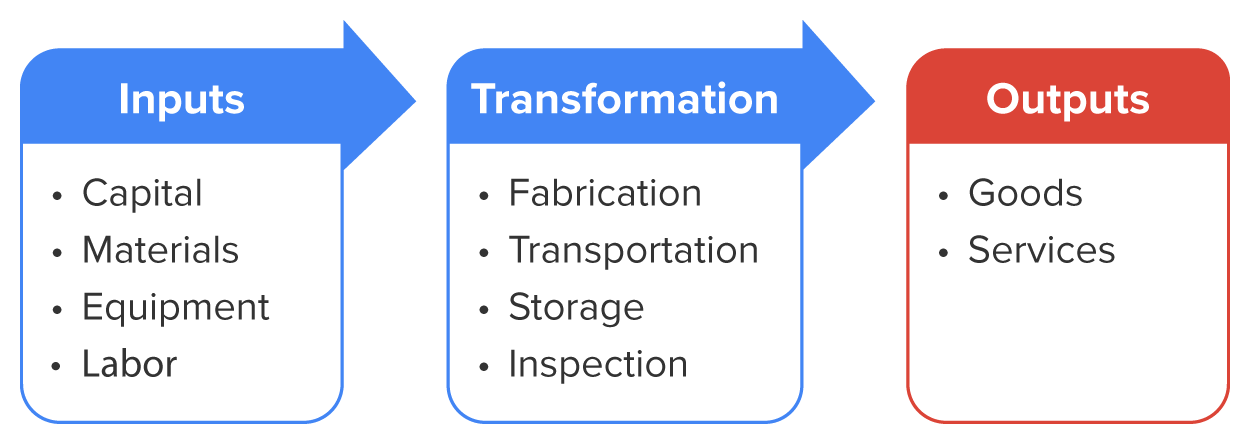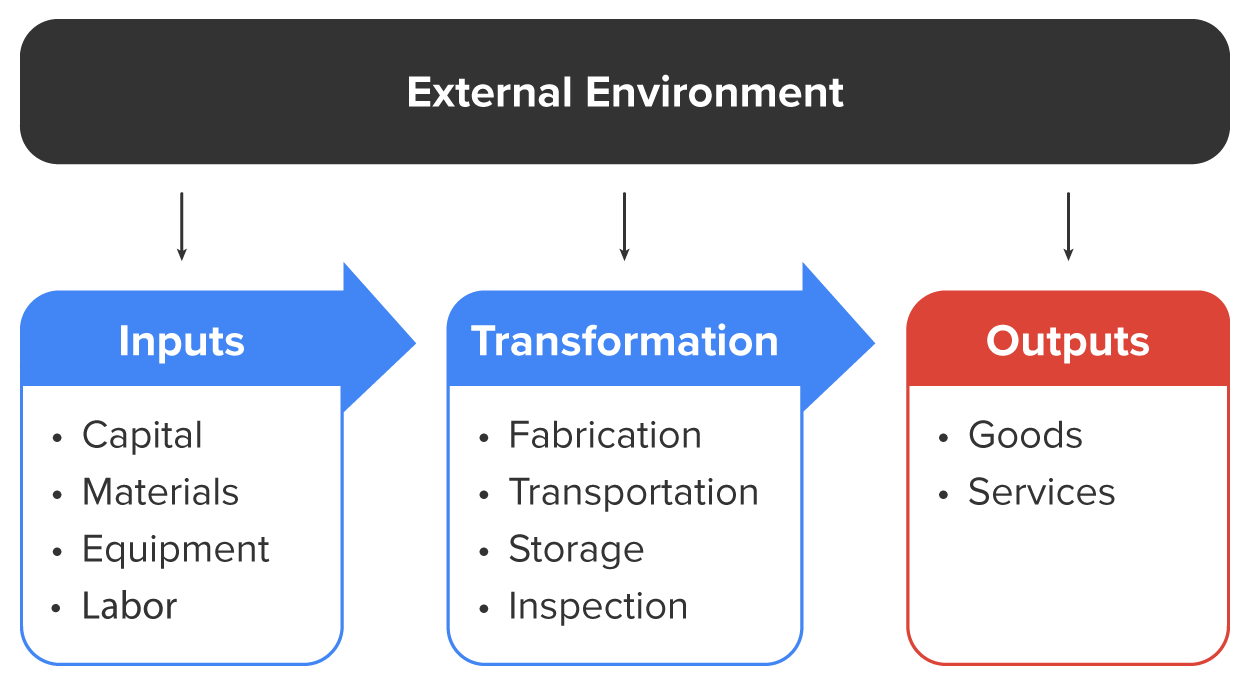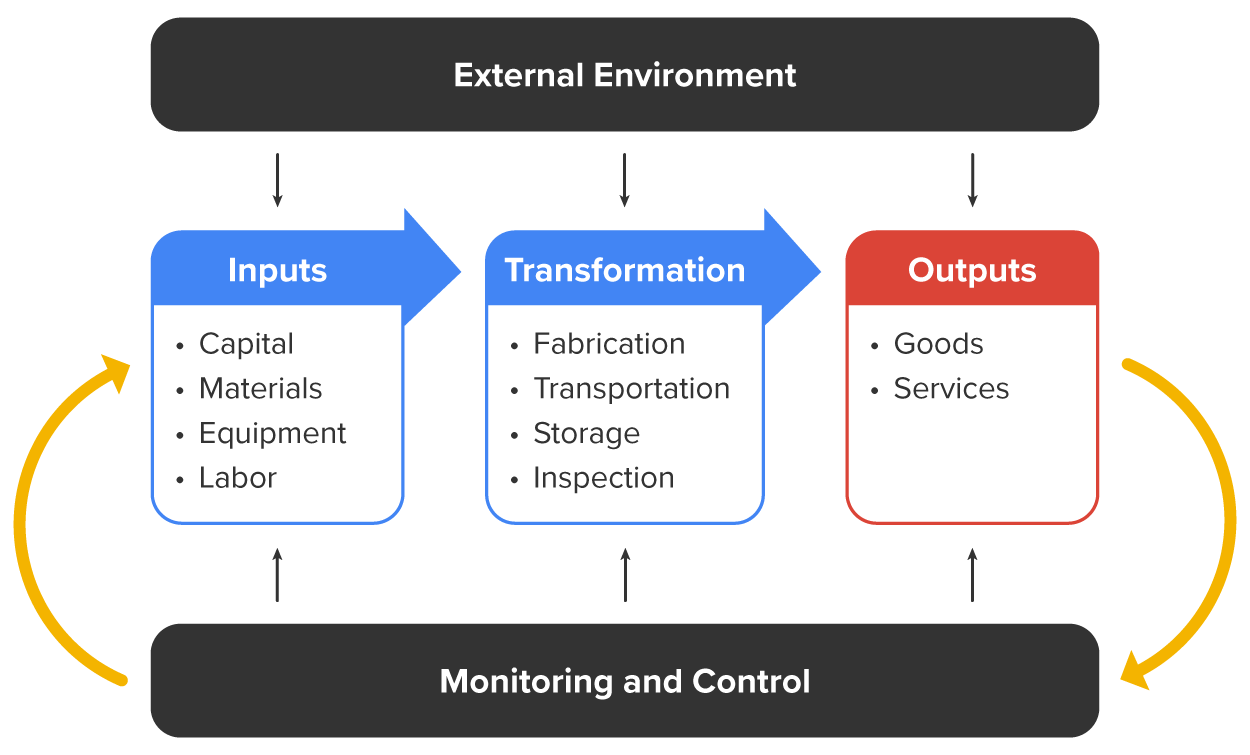Table of Contents |
It does not matter whether the organization is a for-profit company, a non-profit organization (religious organizations, hospitals, etc.), or a government agency; all organizations must strive to maximize the quality of their outputs and the efficiency of their transformation processes to be competitive and accountable to stakeholders, including customers, shareholders, and employees. The processes view of operations management is largely concerned with making sure that the transformation process is as efficient and cost effective as possible.
The model below summarizes the transformation process. The arrow labeled “Transformation System” is the critical element in the model that will determine how well the organization produces goods and services that meet customer needs.

However, while this model shows the key processes, it is not yet complete.
The model shows a simplified view of any organization transforming resources (including people’s time and expertise) into goods and services. However, this work never happens independently of the external environment. In this context, the external environment refers to all factors outside the company that influence its work. Environmental factors include suppliers, customers, competition, government regulation, and so forth, many of which are mostly outside of the organization’s control but nevertheless have a grave impact on how effectively they can do business.
EXAMPLE
A new ballpark can provide a steady stream of walk-in customers on game days to a new restaurant, while a ballpark shutting down or relocating can cause longstanding restaurants to shut down.Even organizations that prepare for contingencies like predictable supply shortages may face more severe changes in the external environment than they can expect or plan for.
EXAMPLE
The auto industry had a shortage of new cars (and a spike in prices) in the years following the 2020 pandemic because there was a shortage of the semiconductors used in the vehicles’ electronic systems. That shortage, in turn, was due to labor limitations and the surge in purchases of home electronics during the pandemic.Naturally, customer needs and interests are also crucial—that is, the inputs and outputs are both highly impacted by the environment and in turn impact the transformation process.
EXAMPLE
The rise and fall of Blockbuster Video and other video rental chains is remarkable for an industry that rose and fell quickly based on changes in the technological environment that greatly influenced customer demand.Most companies perform a review or analysis of the external environment on a regular basis. This helps them plan for external factors that may be out of their control. One tool that companies use for this is the PESTLE analysis. PESTLE stands for political, economic, social, technological, legal and environmental; they represent the major outside factors that impact a business. Note that “external environment” has a broader meaning of all elements affecting a business, but the “environmental” in PESTLE refers to the natural environment and the impact an industry has on clean air, clean water, etc.
Let’s suppose you work for a company that manufactures electric bikes, and you’ve been tasked with identifying elements of the external environment that could impact the company. Here are the questions you might ask yourself:
| PESTLE | Question to Consider |
|---|---|
| Political |
|
| Economic |
|
| Social |
|
| Technological |
|
| Legal |
|
| Environmental |
|
We can revise the model to show the influence the external environment has on the organization.

The external environment has great impact on inputs. Most companies do not produce their own raw materials for production, so the dependence on suppliers is very high. If a company makes furniture, for example, and they can’t obtain wood or fabric, they may struggle to remain in business. Likewise, if there are labor shortages or not enough available talent to perform the necessary tasks, the business could struggle and not be able to make their product or perform their service. Even if the company can get raw materials, they may not be able to keep up with customer demand. In the service industry, for example, if a landscaping business can’t hire people to install new plantings, this impacts the number and frequency of plantings the company can do. Low customer satisfaction with long wait times could lead to a downturn next season. To paraphrase an old joke about a popular restaurant, nobody would go there anymore because it would be too crowded.
Since the transformation process is the process of the actual production of goods and services, the external environment can also have a large impact. For example, the costs of fabrication of a good or service can increase if minimum wage increases. This may result in the need to charge more for the product or cut other aspects of the product to make up for this loss. Costs related to transportation, such as fuel prices, can impact the cost of goods and services. Changes in technology, such as the change to home delivery and expectations of customers to receive products quickly, have changed the way many businesses manage their delivery processes.
When we consider outputs, which are the actual goods and services produced from inputs and transportation, the external environment has major impact. For example, changing consumer tastes can impact product or service demand. Suppose a restaurant focused in creating vegan dishes, but consumer tastes change, and they prefer different types of foods; this, of course, is going to have great impact on the type of outputs the restaurant offers.
Additional competition in the market has impact on outputs too, in terms of the types of outputs, pricing, and expectations the customers have.
IN CONTEXT: 3M
The 3M Company is a good example of the strategic importance of transforming inputs into outputs that provide a competitive advantage in the marketplace. Under the Scotch brand, 3M manufactures a top-quality adhesive tape called “Magic Tape.” Magic Tape offers attractive features that most other tapes do not, including:
These qualities make Magic Tape perfect for wrapping presents, craft projects, and other everyday uses. For over 60 years, 3M has enjoyed a substantial profit margin on its Magic Tape product because 3M engineers make the manufacturing equipment and design the manufacturing processes that produce Magic Tape. In other words, 3M enjoys a commanding competitive advantage by controlling the transformation processes that turn raw material inputs into the high-value-added Magic Tape product.
- Smooth removal from the tape roll
- An adhesive that is sticky enough to hold items in place (but not too sticky that it cannot be removed and readjusted if necessary!)
- A nonreflective surface
Controlling the transformation process makes it extremely difficult for competitors to produce tape of the same quality as Magic Tape, allowing 3M to reap significant profits from this superior product. An opposite example of the strategic implications of the input/output transformation process is 3M’s decision in the 1980s to stop manufacturing VHS tape for video players and recorders. In the VHS tape market, 3M had no proprietary manufacturing advantage, as there were many competitors that could produce high-quality VHS tape at lower cost. Since 3M had no proprietary control over the transformation process for VHS tape that would allow the company to protect its profit margins for this product, it dropped VHS tape from its offerings. The two 3M examples of Magic Tape and VHS tape show how important the transformation process and operations management can be to providing and protecting an organization’s competitive advantage.
The model we’ve shown before reflects a very stable business that puts out the same products year after year. Few businesses work that way. Most are constantly striving to keep up with customer demands, the competition, and other external forces by improving their products, introducing new products, and sometimes discontinuing a product that is not successful. The final part of the process of operations is thus the continued efforts to monitor the performance of products for quality and success on the marketplace and making the necessary changes to inputs and processes to remain competitive.
In terms of monitoring and controlling, this means we need to constantly look at the external environment, through a framework like PESTLE. In addition, organizations should look at their internal environment to make changes as needed to meet both the internal and external environment. Often, companies will use a model such as SWOT (strengths, weakness, opportunities, and threats) to look both internally and externally, so they are better able to monitor both environments.
As a final element in the model, we can add the constant feedback loop between outputs and inputs. Any phase of the process might change due to the environment, and this affects the other two areas. Our final model shows these dynamics.

As seen from this example, organizations need to constantly monitor and control processes as they relate to inputs, transformation, and outputs to be the most effective.
Source: This tutorial has been adapted from Saylor Academy and NSCC “Operations Management”. Access for free at https://pressbooks.nscc.ca/operationsmanagement2/. License: Creative Commons Attribution 4.0 International.